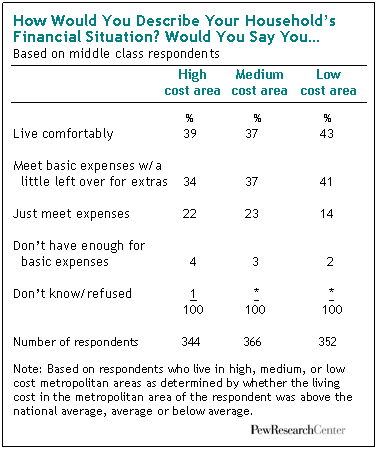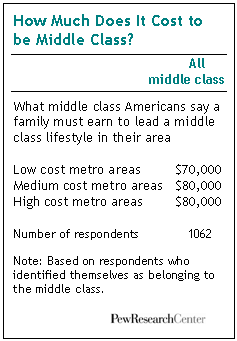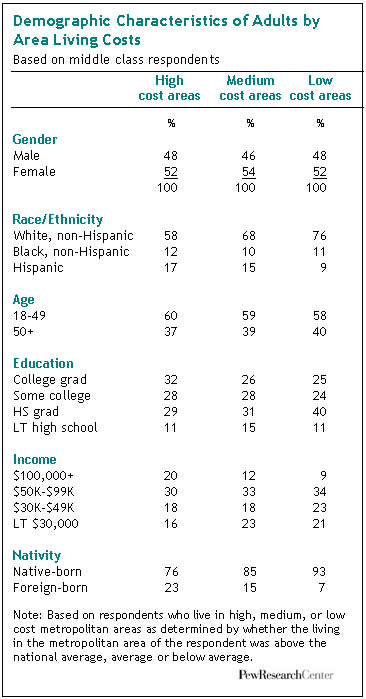When it comes to anxiety about family finances, an old truism applies: Where you stand depends on where you sit. Or, more precisely, on where your house or apartment sits.
 Americans who think of themselves as being in the middle class have differing levels of comfort or distress about their financial situations, and some of that variance is related to where they live, according to a Pew Social & Demographic Trends survey.
Americans who think of themselves as being in the middle class have differing levels of comfort or distress about their financial situations, and some of that variance is related to where they live, according to a Pew Social & Demographic Trends survey.
Adults who call themselves middle class and who live in the nation’s most expensive metropolitan areas have higher incomes and higher costs than do self-identified middle class adults who live in lower-cost regions. They also have more financial stresses. They’re more likely to say they barely make enough to get by, and they’re more likely to say they expect to have trouble paying their bills in the coming year. Moreover, middle class homeowners in high-cost areas are less likely to have paid off their homes than are middle class homeowners in less expensive areas.
These findings are based on responses to a nationwide Pew survey of 2,413 adults that was released in April, combined with an analysis of unpublished numbers from a federal research data base1 that measures living costs in U.S. metropolitan areas relative to the national average. Living costs range from 25% below the national average in the St. Joseph, Mo., area to 50% above the national average in metropolitan New York. For the purposes of this analysis, areas were divided into just three broad tiers, each with an equal number of survey respondents: high-cost areas, including San Francisco, Chicago and Washington, D.C., where living costs were about 17% above average or higher; low-cost areas where living costs were about 13% below average or less; and medium-cost areas with living costs spanning the range in between2.
The survey, conducted January 24 through February 19, 2008, asked respondents to place themselves into one of five socio-economic classes3. Just over half (53%) of all respondents say they are middle class, and this proportion is consistent across the three cost-of-living tiers — with 52% of those who live in high-cost areas, 54% of those in medium-cost areas and 50% of those in low-cost areas saying they are middle class.
Pricey Neighborhoods: More Money, More Stress
Not surprisingly, people who live in high-cost areas and who call themselves middle class tend to have higher incomes than do those who live in low-cost areas and call themselves middle class. In high-cost areas, according to the survey, the median middle class income is in the range of $50,000-75,000 a year; in low-cost areas, it is $30,000-40,000. In addition, there is a higher share of middle class households at the top of the income distribution in those high-cost regions: 20% have incomes of $100,000 or more a year. That is double the proportion in low-cost areas.
 But despite these higher incomes, the self-defined middle class is more financially stretched in high-cost regions than in low-cost regions. For example, more than a quarter of middle class residents of high-cost areas (26%) say they have just enough money for basic expenses, or not even that much. That is higher than the proportion saying so (16%) among middle class residents of low-cost metropolitan areas. Middle class residents of low-cost areas are more likely than those in high-cost regions to say that they live comfortably or have enough for basics plus a little left over for extras, 84% to 73%.
But despite these higher incomes, the self-defined middle class is more financially stretched in high-cost regions than in low-cost regions. For example, more than a quarter of middle class residents of high-cost areas (26%) say they have just enough money for basic expenses, or not even that much. That is higher than the proportion saying so (16%) among middle class residents of low-cost metropolitan areas. Middle class residents of low-cost areas are more likely than those in high-cost regions to say that they live comfortably or have enough for basics plus a little left over for extras, 84% to 73%.
Many middle class residents of pricey areas also see financial problems in their future: 27% say it is likely they will have trouble paying their bills in the coming year. A smaller share of the middle class in low-cost areas is worried about paying the bills, according to the survey. About three-quarters (77%) say that is not a likely concern for them in the coming year, compared with about two-thirds (69%) of the middle class in costly regions.
Within the middle class, there are not only differences in income and in financial anxieties based on where people live, there also are differences in perceptions about the amount of money required to lead a middle class lifestyle. Those who live in medium-cost or high-cost areas believe it takes a median $80,000 a year for a family of four to be considered middle class in their communities. Middle class Americans who live in low-cost areas say it takes $70,000.
Many middle class residents of high-cost regions believe that a yearly income of at least $100,000 is needed for a family of four to live a middle class life — 30% say so. Among middle class residents of low-cost metropolitan areas, only 15% agree.
 Homes and Possessions
Homes and Possessions
There also are differences between high-cost and low-cost areas of the country in the likelihood of owning one’s home outright, according to the survey. Middle class Americans in high-cost metropolitan areas are less likely to have paid off their mortgages than those who live in less expensive regions, putting them at greater risk in a housing market downturn. Only a fifth (22%) say their homes are paid off, compared with a third (31%) of the middle class in low-cost regions.
Real estate is a larger share of personal wealth in high-cost areas. Among the middle class, 41% of those who live in expensive regions say that their homes account for more than half their financial worth. Only a quarter (24%) of middle class Americans in low-cost metropolitan areas say so. Of course, homes in costly areas also are worth more: 69% of middle class respondents in those regions say the value of their homes is $250,000 or more. That compares with 14% of the middle class in low-cost areas.
Despite these differences, though, middle class residents of costly and low-cost areas are about equally likely to have lifestyle amenities such as flat-screen TVs, two or more cars, and paid household help. Vacation homes and high-speed internet access are exceptions to this pattern: 11% of the middle class have vacation homes and 76% have high-speed internet in high-cost areas, compared with 6% of the middle class in low-cost areas who have vacation homes and 67% who have high-speed internet.
Who Lives Where
There are some demographic differences between the self-described middle class in high- and low-cost areas. High-cost areas have a larger share of immigrants and racial or ethnic minorities than do low-cost regions, reflecting overall population patterns. Six-in-ten middle class residents of high-cost regions have at least some college education, compared with about half of those who live in low-cost areas.
The survey responses reveal some differences in attitudes and behaviors between high- and low-cost areas, notably on politics and religion. Middle class residents of low-cost areas are more likely to attend religious services regularly, and to say that religion is very important to them. Four-in-ten (40%) middle class Americans in low cost regions describe their political ideology as conservative, compared with 27% of middle class residents of high-cost areas. Expensive regions have a larger share of self-described liberals in the middle class, 24% v. 17%.


